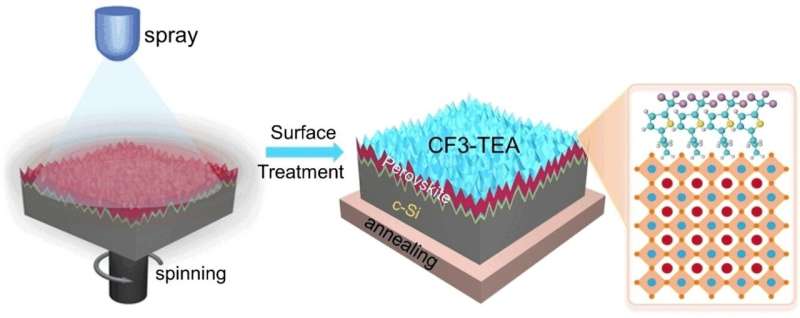This article has been reviewed according to Science X's editorial process and policies. Editors have highlighted the following attributes while ensuring the content's credibility:
fact-checked
peer-reviewed publication
trusted source
proofread
Surface modification for more effective textured perovskite/silicon tandem solar cells

A coating of solar cells with special organic molecules could pave the way for a new generation of solar panels. As a research team reports in the journal Angewandte Chemie International Edition, this coating can increase the efficiency of monolithic tandem cells made of silicon and perovskite while lowering their cost because they are produced from industrial, microstructured, standard silicon wafers.
In solar cells, light "knocks" electrons out of a semiconductor, leaving behind positively charged "holes." These two charge carriers are separated from each other and can be collected as current.
Tandem cells were developed to better exploit the entire spectrum of sunlight and increase solar cell efficiency. Tandem cells are made of two different semiconductors that absorb different wavelengths of light. Primary contenders for use in this technology are a combination of silicon, which absorbs mostly red and near-infrared light, and perovskite, which very efficiently uses visible light.
Monolithic tandem cells are made by coating a support with the two types of semiconductor, one on top of the other. For a perovskite/silicon system, this is usually achieved by using silicon wafers that are produced by the zone melting process and have a polished or nanostructured surface. However, these are very expensive.
Silicon wafers produced by the Czochralski process with micrometer-scale pyramidal structural elements on their surfaces are significantly cheaper. These microtextures result in better light capture because they are less reflective than a smooth surface. However, the process of coating these wafers with perovskite results in many defects in the crystal lattice, which affect the electronic properties.
Transfer of the released electrons is impeded, and electron-hole recombination increasingly occurs through processes that do not emit light. Both the efficiency and the stability of the perovskite layer are decreased.
Headed by Prof. Kai Yao, a Chinese team at Nanchang University, Suzhou Maxwell Technologies, the CNPC Tubular Goods Research Institute (Shaanxi), the Hong Kong Polytechnic University, the Wuhan University of Technology, and Fudan University (Shanghai) has now developed a strategy for surface passivation that allows the surface defects of the perovskite layer to be smoothed out.
A thiophenethylammonium compound with a trifluoromethyl group (CF3-TEA) is applied by a dynamic spray coating process. This forms a very uniform coat—even on microtextured surfaces.
Due to its high polarity and binding energy, the CF3-TEA coating very effectively weakens the effects of the surface defects. Nonradiative recombination is suppressed, and the electronic levels are adjusted so that the electrons at the interface can be more easily transferred to the electron-capturing layer of the solar cell.
Surface modification with CF3-TEA allows perovskite/silicon tandem solar cells based on common textured wafers made of Czochralski silicon to attain a very high efficiency of nearly 31% and maintain long-term stability.
More information: Jun Chen et al, Surface Molecular Engineering for Fully Textured Perovskite/Silicon Tandem Solar Cells, Angewandte Chemie International Edition (2024). DOI: 10.1002/anie.202407151
Journal information: Angewandte Chemie International Edition
Provided by Wiley




















